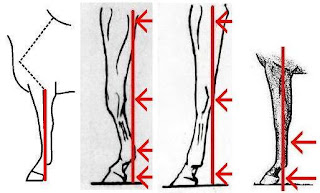So here are examples similar to what I have found so far in the search for 'Conformation - Form to Function'.
I have seen and I have shown you, or directed you to some very good drawings of 'Points' or 'Parts' of a horse.
Now I do know enough that I can tell that the above horse is in trouble. It has a few problems. What the problems are called and caused by, I do not know yet. In the previous post is listed more descriptive 'fault' terms than I even figured could go wrong with a horse. There are a lot of 'bone and joint', 'tendon and ligament' terms I need to know before I can understand the horse's conformation....And then there is the 'perfect' (?) horse.
What are they measuring? What anatomical points are used? What do all those lines and angles mean? What structures determine all those lines and angles?
More lines and angles and even a 'trapezoid'!!!!!!!! Below is what we have to deal with and why we need a lot of words of explanation.
We must examine the horse from the front (anterior) view.
The head and neck. Near side and off sides for all side exams.
More head, neck, and shoulder measurements.
Frontlimb, knee, and pastern exam.
Back and rump exam.
Hindlimb side and rear (posterior) views.
I shall repeat myself - What are they measuring? What anatomical points are used? What do all those lines and angles mean? What structures determine all those lines and angles?
And, And,
The Gaits.
We will go to the skeletal structure first and then return to these sites for more photos and detailed descriptive textual explanations of horse conformation 'form to function'.























No comments:
Post a Comment